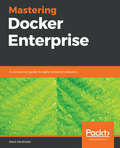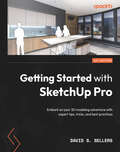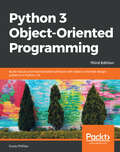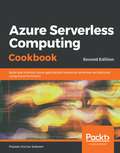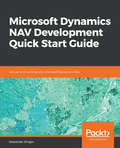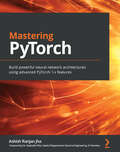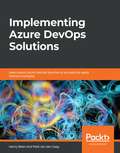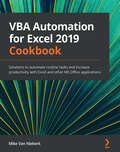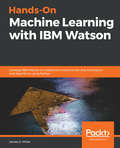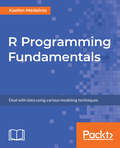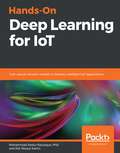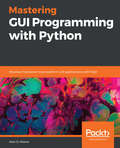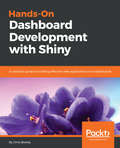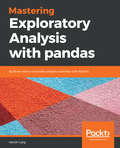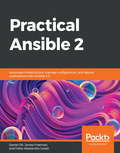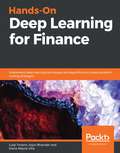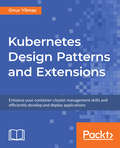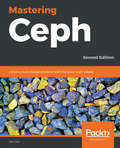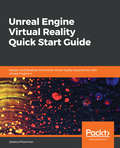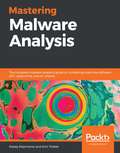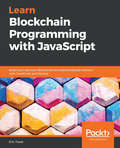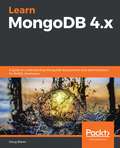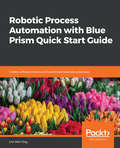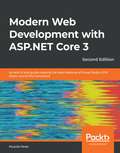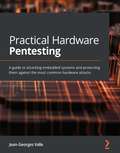- Table View
- List View
Mastering Docker Enterprise: A companion guide for agile container adoption
by Mark PanthoferA journey toward containerized applications in production with a cloud-portable, secure, robust and highly available Docker Enterprise platform. Key Features Get an insider's view into the container movement and Docker Enterprise Manage the transformation associated with enterprise container adoption Walk through the enterprise container adoption journey Book Description While known mostly as the open source engine behind tens of millions of server nodes, Docker also offers commercially supported enterprise tooling known as the Docker Enterprise. This platform leverages the deep roots from Docker Engine - Community (formerly Docker CE) and Kubernetes, but adds support and tooling to efficiently operate a secure container platform at scale. With hundreds of enterprises on board, best practices and adoption patterns are emerging rapidly. These learning points can be used to inform adopters and help manage the enterprise transformation associated with enterprise container adoption. This book starts by explaining the case for Docker Enterprise, as well as its structure and reference architecture. From there, we progress through the PoC,pilot and production stages as a working model for adoption, evolving the platform's design and configuration for each stage and using detailed application examples along the way to clarify and demonstrate important concepts.The book concludes with Docker's impact on other emerging software technologies, such as Blockchain and Serverless computing. By the end of this book, you'll have a better understanding of what it takes to get your enterprise up and running with Docker Enterprise and beyond. What you will learn Understand why containers are important to an enterprise Understand the features and components of Docker Enterprise 2 Find out about the PoC, pilot, and production adoption phases Get to know the best practices for installing and operating Docker Enterprise Understand what is important for a Docker Enterprise in production Run Kubernetes on Docker Enterprise Who this book is for This book is for Software Architects, DevOps Engineers, Tech Ops, Docker professionals, or any IT professional working with Docker and containers who wants to move containerized workloads to production. This book discusses the enterprise adoption of Docker and Kubernetes,therefore a basic understanding of Docker concepts will be helpful.
Getting Started with SketchUp Pro: Embark on your 3D modeling adventure with expert tips, tricks, and best practices
by David S. SellersLevel up your 3D design skills with SketchUp Pro by employing real-world examples and design guidelinesPurchase of the print or Kindle book includes a free PDF eBookKey FeaturesPut your architectural design knowledge to work by exploring practical examplesGain a deeper understanding of SketchUp's GUI, modeling tools, and editing featuresExecute full design creations with detailed steps without getting overwhelmed by SketchUp's advanced functionalitiesBook DescriptionOwing to its ability to create models quickly and with high level of dimensional accuracy, SketchUp Pro has become a popular choice for many industries, including architecture, interior design, landscape architecture, and video game design. If you are seeking to adopt Trimble's exceptional design software, Getting Started with SketchUp Pro serves as an ideal primer to prepare and equip you for its use. This book will help you lay the foundation of a project from scratch, set up appropriate units, and follow a guided path to structure your 3D models. You'll explore the workflows used for creating designs from sketches, making CAD drawings (DWG), and even updating your existing 3D models. Finally, you'll work with extensions and 3D Warehouse to find new workflows and models to add to your skill set. By the end of this SketchUp book, you'll be able to confidently create and share models of your design through CAD drawings and 3D views, and even take them online through the 3D WarehouseWhat you will learnBuild massing 3D models and preliminary designsIdentify optimal methods to boost productivity and efficiency with SketchUp ProExplore SketchUp tools and understand their diverse functionalityGet a complete walkthrough of editing tools, materials, and components in SketchUpCreate and edit components and explore component optionsGet acquainted with SketchUp extensions, 3D Warehouse, and additional tools and resourcesWho this book is forThis book is for architects, landscape architects, interior designers, woodworkers, and 3D modelers with beginner-level knowledge of the architectural design of living spaces. Basic computer skills are all you need to get started.
Python 3 Object-Oriented Programming: Build robust and maintainable software with object-oriented design patterns in Python 3.8, 3rd Edition
by Dusty PhillipsUncover modern Python with this guide to Python data structures, design patterns, and effective object-oriented techniquesKey FeaturesIn-depth analysis of many common object-oriented design patterns that are more suitable to Python's unique styleLearn the latest Python syntax and librariesExplore abstract design patterns and implement them in Python 3.8Book DescriptionObject-oriented programming (OOP) is a popular design paradigm in which data and behaviors are encapsulated in such a way that they can be manipulated together. This third edition of Python 3 Object-Oriented Programming fully explains classes, data encapsulation, and exceptions with an emphasis on when you can use each principle to develop well-designed software. Starting with a detailed analysis of object-oriented programming, you will use the Python programming language to clearly grasp key concepts from the object-oriented paradigm. You will learn how to create maintainable applications by studying higher level design patterns. The book will show you the complexities of string and file manipulation, and how Python distinguishes between binary and textual data. Not one, but two very powerful automated testing systems, unittest and pytest, will be introduced in this book. You'll get a comprehensive introduction to Python's concurrent programming ecosystem. By the end of the book, you will have thoroughly learned object-oriented principles using Python syntax and be able to create robust and reliable programs confidently.What you will learnImplement objects in Python by creating classes and defining methodsGrasp common concurrency techniques and pitfalls in Python 3Extend class functionality using inheritanceUnderstand when to use object-oriented features, and more importantly when not to use themDiscover what design patterns are and why they are different in PythonUncover the simplicity of unit testing and why it's so important in PythonExplore concurrent object-oriented programmingWho this book is forIf you're new to object-oriented programming techniques, or if you have basic Python skills and wish to learn in depth how and when to correctly apply OOP in Python, this is the book for you. If you are an object-oriented programmer for other languages or seeking a leg up in the new world of Python 3.8, you too will find this book a useful introduction to Python. Previous experience with Python 3 is not necessary.
Azure Serverless Computing Cookbook - Second Edition: Build and monitor Azure applications hosted on serverless architecture using Azure Functions, 2nd Edition
by S Praveen KumarIf you are a cloud administrator, architect, or developer who wants to build scalable systems and deploy serverless applications with Azure functions, then this book is for you. Hands-on experience with core services of Microsoft Azure is required.
Microsoft Dynamics NAV Development Quick Start Guide: Get up and running with Microsoft Dynamics NAV
by Alexander DroginLearn development skills and improve productivity when programming in Microsoft Dynamics NAV 2018 - the popular Enterprise Resourse Planning management system used across a variety of industries for business process management Key Features Solve common business problems with the valuable features and flexibility of Dynamics NAV Understand the structure of NAV database - how documents and business entities are mapped to DB tables Design user interface and bind the presentation layer with the data storage Book Description Microsoft Dynamics NAV is an enterprise resource planning (ERP) software suite for organizations. The system offers specialized functionality for manufacturing, distribution, government, retail, and other industries. This book gets you started with its integrated development environment for solving problems by customizing business processes. This book introduces the NAV development environment – C/SIDE. It gives an overview of the internal system language and the most essential development tools. The book will enable the reader to customize and extend NAV functionality with C/AL code, design a user interface through pages, create role centers, and build advanced reports in Microsoft Visual Studio. By the end of the book, you will have learned how to extend the NAV data model, how to write and debug custom code, and how to exchange data with external applications. What you will learn Manage NAV Server configuration with Microsoft Management Console Manage NAV installation with the NAV Administration Shell Create integration events and extend functionality via the NAV event model Run XML Ports from C/AL code Design reports and write client code in RDLC expressions Who this book is for This book is for experienced NAV users who have an understanding of basic programming concepts. Familiarity with NAV development environment or its internal development language-C/AL is not expected.
Mastering PyTorch: Build powerful neural network architectures using advanced PyTorch 1.x features
by Ashish Ranjan Jha Dr. Gopinath PillaiMaster advanced techniques and algorithms for deep learning with PyTorch using real-world examplesKey FeaturesUnderstand how to use PyTorch 1.x to build advanced neural network modelsLearn to perform a wide range of tasks by implementing deep learning algorithms and techniquesGain expertise in domains such as computer vision, NLP, Deep RL, Explainable AI, and much moreBook DescriptionDeep learning is driving the AI revolution, and PyTorch is making it easier than ever before for anyone to build deep learning applications. This PyTorch book will help you uncover expert techniques to get the most out of your data and build complex neural network models. The book starts with a quick overview of PyTorch and explores using convolutional neural network (CNN) architectures for image classification. You'll then work with recurrent neural network (RNN) architectures and transformers for sentiment analysis. As you advance, you'll apply deep learning across different domains, such as music, text, and image generation using generative models and explore the world of generative adversarial networks (GANs). You'll not only build and train your own deep reinforcement learning models in PyTorch but also deploy PyTorch models to production using expert tips and techniques. Finally, you'll get to grips with training large models efficiently in a distributed manner, searching neural architectures effectively with AutoML, and rapidly prototyping models using PyTorch and fast.ai. By the end of this PyTorch book, you'll be able to perform complex deep learning tasks using PyTorch to build smart artificial intelligence models.What you will learnImplement text and music generating models using PyTorchBuild a deep Q-network (DQN) model in PyTorchExport universal PyTorch models using Open Neural Network Exchange (ONNX)Become well-versed with rapid prototyping using PyTorch with fast.aiPerform neural architecture search effectively using AutoMLEasily interpret machine learning (ML) models written in PyTorch using CaptumDesign ResNets, LSTMs, Transformers, and more using PyTorchFind out how to use PyTorch for distributed training using the torch.distributed APIWho this book is forThis book is for data scientists, machine learning researchers, and deep learning practitioners looking to implement advanced deep learning paradigms using PyTorch 1.x. Working knowledge of deep learning with Python programming is required.
Implementing Azure DevOps Solutions: Learn about Azure DevOps Services to successfully apply DevOps strategies
by Henry Been Maik Van GaagThis book targets software developers and operations specialists interested in implementing DevOps practices for the Azure cloud. Application developers and IT professionals with some experience in software development and development practices would find this book useful. Some familiarity with basic usage of Azure DevOps is an added advantage.
VBA Automation for Excel 2019 Cookbook: Solutions to automate routine tasks and increase productivity with Excel and other MS Office applications
by Mike Van NiekerkA comprehensive guide to gaining a 360-degree overview of the VBA programming language and learning how to build your own programs for automating routine tasksKey FeaturesExtend the capabilities of Excel and other Office applications with the help of Microsoft VBATake your Excel programming skills to the next level by creating custom applications with dialogue boxes and the range objectAutomate repetitive and monotonous office work with VBA Excel programmingBook DescriptionVisual Basic for Applications (VBA) is a programming language developed by Microsoft to automate tasks in MS Office applications. This book will help you to focus on the essential aspects of your role by automating mundane tasks in Excel and other Office applications. With comprehensive coverage of VBA delivered in the form of practice problems and bite-sized recipes, this book will help you to hit the ground running. Unlike most books that assume prior programming experience, this book starts with the fundamentals and gradually progresses to solving bigger problems. You'll start by becoming familiar with VBA so that you can start recording macros right away. With this foundation in place, you'll advance to using the full capabilities of the language as you apply loops, functions, and custom dialog boxes to design your own automation programs. You'll also get to grips with embedded macros and other advanced tools to enhance productivity and explore topics relating to app performance and security. Throughout this VBA book, you'll cover multiple practice projects in Excel, Word, and PowerPoint while exploring tips and best practices to hone your skills. By the end of this book, you'll have developed the skills you need to use VBA to create your own programs that control MS Office applications.What you will learnUnderstand the VBA programming language's role in the context of the MS Office suiteDiscover various aspects of VBA programming such as its terminology, syntax, procedures, functions, and formsInvestigate the elements, features, and characteristics of the VBA Editor to write and edit custom scriptsAutomate Excel sheets with the help of rangesExplore error handling and debugging techniques to catch bugs in your programsCreate and use custom dialog boxes to collect data from usersCustomize and extend Office apps such as Excel, PowerPoint, and WordWho this book is forThis book is for experienced Excel users, business analysts, finance professionals, and business users looking to boost their productivity by learning VBA programming to automate repetitive, tedious, or complex tasks. No prior programming experience is required to get started with this book.
Hands-On Machine Learning with IBM Watson: Leverage IBM Watson to implement machine learning techniques and algorithms using Python
by James MillerThis book is for Data Scientists and Machine Learning Engineers who would like to get introduced to the IBM Cloud and its Machine learning services using practical examples. Basic Python knowledge and limited understanding of Machine Learning will be beneficial.
R Programming Fundamentals: Deal with data using various modeling techniques
by Kaelen MedeirosStudy data analysis and visualization to successfully analyze data with RKey FeaturesGet to grips with data cleaning methodsExplore statistical concepts and programming in R, including best practicesBuild a data science project with real-world examplesBook DescriptionR Programming Fundamentals, focused on R and the R ecosystem, introduces you to the tools for working with data. To start with, you’ll understand you how to set up R and RStudio, followed by exploring R packages, functions, data structures, control flow, and loops.Once you have grasped the basics, you’ll move on to studying data visualization and graphics. You’ll learn how to build statistical and advanced plots using the powerful ggplot2 library. In addition to this, you’ll discover data management concepts such as factoring, pivoting, aggregating, merging, and dealing with missing values.By the end of this book, you’ll have completed an entire data science project of your own for your portfolio or blog.What you will learnUse basic programming concepts of R such as loading packages, arithmetic functions, data structures, and flow controlImport data to R from various formats such as CSV, Excel, and SQLClean data by handling missing values and standardizing fieldsPerform univariate and bivariate analysis using ggplot2Create statistical summary and advanced plots such as histograms, scatter plots, box plots, and interaction plotsApply data management techniques, such as factoring, pivoting, aggregating, merging, and dealing with missing values, on the example datasetsWho this book is forR Programming Fundamentals is for you if you are an analyst who wants to grow in the field of data science and explore the latest tools.
Hands-On Deep Learning for IoT: Train neural network models to develop intelligent IoT applications
by Md. Rezaul Karim Mohammad Abdur Razzaque, PhDImplement popular deep learning techniques to make your IoT applications smarter Key Features Understand how deep learning facilitates fast and accurate analytics in IoT Build intelligent voice and speech recognition apps in TensorFlow and Chainer Analyze IoT data for making automated decisions and efficient predictions Book Description Artificial Intelligence is growing quickly, which is driven by advancements in neural networks(NN) and deep learning (DL). With an increase in investments in smart cities, smart healthcare, and industrial Internet of Things (IoT), commercialization of IoT will soon be at peak in which massive amounts of data generated by IoT devices need to be processed at scale. Hands-On Deep Learning for IoT will provide deeper insights into IoT data, which will start by introducing how DL fits into the context of making IoT applications smarter. It then covers how to build deep architectures using TensorFlow, Keras, and Chainer for IoT. You'll learn how to train convolutional neural networks(CNN) to develop applications for image-based road faults detection and smart garbage separation, followed by implementing voice-initiated smart light control and home access mechanisms powered by recurrent neural networks(RNN). You'll master IoT applications for indoor localization, predictive maintenance, and locating equipment in a large hospital using autoencoders, DeepFi, and LSTM networks. Furthermore, you'll learn IoT application development for healthcare with IoT security enhanced. By the end of this book, you will have sufficient knowledge need to use deep learning efficiently to power your IoT-based applications for smarter decision making. What you will learn Get acquainted with different neural network architectures and their suitability in IoT Understand how deep learning can improve the predictive power in your IoT solutions Capture and process streaming data for predictive maintenance Select optimal frameworks for image recognition and indoor localization Analyze voice data for speech recognition in IoT applications Develop deep learning-based IoT solutions for healthcare Enhance security in your IoT solutions Visualize analyzed data to uncover insights and perform accurate predictions Who this book is for If you're an IoT developer, data scientist, or deep learning enthusiast who wants to apply deep learning techniques to build smart IoT applications, this book is for you. Familiarity with machine learning, a basic understanding of the IoT concepts, and some experience in Python programming will help you get the most out of this book.
Mastering GUI Programming with Python: Develop impressive cross-platform GUI applications with PyQt
by Alan MooreAn advanced guide to creating powerful high-performance GUIs for modern, media-rich applications in various domains such as business and game developmentKey FeaturesGain comprehensive knowledge of Python GUI development using PyQt 5.12Explore advanced topics including multithreaded programming, 3D animation, and SQL databasesBuild cross-platform GUIs for Windows, macOS, Linux, and Raspberry PiBook DescriptionPyQt5 has long been the most powerful and comprehensive GUI framework available for Python, yet there is a lack of cohesive resources available to teach Python programmers how to use it. This book aims to remedy the problem by providing comprehensive coverage of GUI development with PyQt5. You will get started with an introduction to PyQt5, before going on to develop stunning GUIs with modern features. You will then learn how to build forms using QWidgets and learn about important aspects of GUI development such as layouts, size policies, and event-driven programming. Moving ahead, you’ll discover PyQt5’s most powerful features through chapters on audio-visual programming with QtMultimedia, database-driven software with QtSQL, and web browsing with QtWebEngine. Next, in-depth coverage of multithreading and asynchronous programming will help you run tasks asynchronously and build high-concurrency processes with ease. In later chapters, you’ll gain insights into QOpenGLWidget, along with mastering techniques for creating 2D graphics with QPainter. You’ll also explore PyQt on a Raspberry Pi and interface it with remote systems using QtNetwork. Finally, you will learn how to distribute your applications using setuptools and PyInstaller. By the end of this book, you will have the skills you need to develop robust GUI applications using PyQt. What you will learn: Get to grips with the inner workings of PyQt5; Learn how elements in a GUI application communicate with signals and slots; Learn techniques for styling an application; Explore database-driven applications with the QtSQL module; Create 2D graphics with QPainter; Delve into 3D graphics with QOpenGLWidget; Build network and web-aware applications with QtNetwork and QtWebEngine. Who this book is for: This book is for programmers who want to create attractive, functional, and powerful GUIs using the Python language. You’ll also find this book useful if you are a student, professional, or anyone who wants to start exploring GUIs or take your skills to the next level. Although prior knowledge of the Python language is assumed, experience with PyQt, Qt, or GUI programming is not required.
Hands-On Dashboard Development with Shiny: A practical guide to building effective web applications and dashboards
by Chris BeeleyProgressively explore UI development with Shiny via practical examplesKey FeaturesWrite a Shiny interface in pure HTMLExplore powerful layout functions to make attractive dashboards and other intuitive interfacesGet to grips with Bootstrap and leverage it in your Shiny applicationsBook DescriptionAlthough vanilla Shiny applications look attractive with some layout flexibility, you may still want to have more control over how the interface is laid out to produce a dashboard. Hands-On Dashboard Development with Shiny helps you incorporate this in your applications.The book starts by guiding you in producing an application based on the diamonds dataset included in the ggplot2 package. You’ll create a single application, but the interface will be reskinned and rebuilt throughout using different methods to illustrate their uses and functions using HTML, CSS, and JavaScript. You will also learn to develop an application that creates documents and reports using R Markdown. Furthermore, the book demonstrates the use of HTML templates and the Bootstrap framework. Moving along, you will learn how to produce dashboards using the Shiny command and dashboard package. Finally, you will learn how to lay out applications using a wide range of built-in functions.By the end of the book, you will have an understanding of the principles that underpin layout in Shiny applications, including sections of HTML added to a vanilla Shiny application, HTML interfaces written from scratch, dashboards, navigation bars, and interfaces.What you will learnAdd HTML to a Shiny application and write its interfaces from scratch in HTMLUse built-in Shiny functions to produce attractive and flexible layoutsProduce dashboards, adding icons and notificationsExplore Bootstrap themes to lay out your applicationsGet insights into UI development with hands-on examplesUse R Markdown to create and download reportsWho this book is forIf you have some experience writing Shiny applications and want to use HTML, CSS, and Bootstrap to make custom interfaces, then this book is for you.
Mastering Exploratory Analysis with pandas: Build an end-to-end data analysis workflow with Python
by Harish GargExplore Python frameworks like pandas, Jupyter notebooks, and Matplotlib to build data pipelines and data visualizationKey FeaturesLearn to set up data analysis pipelines with pandas and Jupyter notebooksEffective techniques for data selection, manipulation, and visualizationIntroduction to Matplotlib for interactive data visualization using charts and plotsBook DescriptionThe pandas is a Python library that lets you manipulate, transform, and analyze data. It is a popular framework for exploratory data visualization and analyzing datasets and data pipelines based on their properties.This book will be your practical guide to exploring datasets using pandas. You will start by setting up Python, pandas, and Jupyter Notebooks. You will learn how to use Jupyter Notebooks to run Python code. We then show you how to get data into pandas and do some exploratory analysis, before learning how to manipulate and reshape data using pandas methods. You will also learn how to deal with missing data from your datasets, how to draw charts and plots using pandas and Matplotlib, and how to create some effective visualizations for your audience. Finally, you will wrapup your newly gained pandas knowledge by learning how to import data out of pandas into some popular file formats.By the end of this book, you will have a better understanding of exploratory analysis and how to build exploratory data pipelines with Python.What you will learnLearn how to read different kinds of data into pandas DataFrames for data analysis Manipulate, transform, and apply formulas to data imported into pandas DataFramesUse pandas to analyze and visualize different kinds of data to gain real-world insights Extract transformed data form pandas DataFrames and convert it into the formats your application expectsManipulate model time-series data, perform algorithmic trading, derive results on fixed and moving windows, and more Effective data visualization using MatplotlibWho this book is forIf you are a budding data scientist looking to learn the popular pandas library, or a Python developer looking to step into the world of data analysis, this book is the ideal resource you need to get started. Some programming experience in Python will be helpful to get the most out of this course
Practical Ansible 2: Automate infrastructure, manage configuration, and deploy applications with Ansible 2.9
by James Freeman Fabio Alessandro Locati Daniel OhLeverage the power of Ansible to gain complete control over your systems and automate application deployment Key Features Use Ansible 2.9 to automate and control your infrastructure Delve into advanced functionality such as plugins and custom modules in Ansible Automate and orchestrate major cloud platforms such as OpenStack, AWS, and Azure using Ansible Book Description Ansible enables you to automate software provisioning, configuration management, and application roll-outs, and can be used as a deployment and orchestration tool. While Ansible provides simple yet powerful features to automate multi-layer environments using agentless communication, it can also solve other critical IT challenges, such as ensuring continuous integration and continuous deployment (CI/CD) with zero downtime. In this book, you'll work with Ansible 2.9 and learn to solve complex issues quickly with the help of task-oriented scenarios. You'll start by installing and configuring Ansible on Linux and macOS to automate monotonous and repetitive IT tasks and get to grips with concepts such as playbooks, inventories, and network modules. As you progress, you'll gain insight into the YAML syntax and learn how to port between Ansible versions. In addition to this, you'll also understand how Ansible enables you to orchestrate multi-layer environments such as networks, containers, and the cloud. By the end of this Ansible book, you'll be well - versed in writing playbooks and other related Ansible code to overcome just about all of your IT challenges, from infrastructure-as-code provisioning to application deployments, and even handling the mundane day-to-day maintenance tasks that take up so much valuable time. What you will learn Become familiar with the fundamentals of the Ansible framework Set up role-based variables and dependencies Avoid common mistakes and pitfalls when writing automation code in Ansible Extend Ansible by developing your own modules and plugins Contribute to the Ansible project by submitting your own code Follow best practices for working with cloud environment inventories Troubleshoot issues triggered during Ansible playbook runs Who this book is for If you are a DevOps engineer, administrator, or any IT professional looking to automate IT tasks using Ansible, this book is for you. Prior knowledge of Ansible is not necessary.
Hands-On Deep Learning for Finance: Implement deep learning techniques and algorithms to create powerful trading strategies
by Luigi Troiano Arjun Bhandari Elena Mejuto VillaTake your quantitative strategies to the next level by exploring nine examples that make use of cutting-edge deep learning technologies, including CNNs, LSTMs, GANs, reinforcement learning, and CapsNets Key Features Implement deep learning techniques and algorithms to build financial models Apply modern AI techniques in quantitative market modeling and investment decision making Leverage Python libraries for rapid development and prototyping Book Description Quantitative methods are the vanguard of the investment management industry. This book shows how to enhance trading strategies and investments in financial markets using deep learning algorithms. This book is an excellent reference to understand how deep learning models can be leveraged to capture insights from financial data. You will implement deep learning models using Python libraries such as TensorFlow and Keras. You will learn various deep learning algorithms to build models for understanding financial market dynamics and exploiting them in a systematic manner. This book takes a pragmatic approach to address various aspects of asset management. The information content in non-structured data like news flow is crystalized using BLSTM. Autoencoders for efficient index replication is discussed in detail. You will use CNN to develop a trading signal with simple technical indicators, and improvements offered by more complex techniques such as CapsNets. Volatility is given due emphasis by demonstrating the superiority of forecasts employing LSTM, and Monte Carlo simulations using GAN for value at risk computations. These are then brought together by implementing deep reinforcement learning for automated trading. This book will serve as a continuing reference for implementing deep learning models to build investment strategies. What you will learn Implement quantitative financial models using the various building blocks of a deep neural network Build, train, and optimize deep networks from scratch Use LSTMs to process data sequences such as time series and news feeds Implement convolutional neural networks (CNNs), CapsNets, and other models to create trading strategies Adapt popular neural networks for pattern recognition in finance using transfer learning Automate investment decisions by using reinforcement learning Discover how a risk model can be constructed using D-GAN Who this book is for If you're a finance or investment professional who wants to lead the development of quantitative strategies, this book is for you. With this practical guide, you'll be able to use deep learning methods for building financial models and incorporating them in your investment process. Anyone who wants to enter the fascinating domain of quantitative finance using the power of deep learning algorithms and techniques will also find this book useful. Basic knowledge of machine learning and Python programming is required.
Kubernetes Design Patterns and Extensions: Enhance your container-cluster management skills and efficiently develop and deploy applications
by Onur YilmazMaster the art of container management with Kubernetes and study robust container orchestration to ensure that your container-based applications sail into production without hiccupsKey FeaturesImplement best practices in cloud-native applications using KubernetesExplore the usage of client libraries and programmatic access to Kubernetes Use your domain expertise to codeBook DescriptionBefore plunging into how Kubernetes works, this book introduces you to the world of container orchestration and describes the recent changes in application development. You'll understand problems that Kubernetes solves and get to grips with using Kubernetes resources to deploy applications. In addition to this, you'll learn to apply the security model of Kubernetes clusters.Kubernetes Design Patterns and Extensions describes how services running in Kubernetes can leverage the platform's security features. Once you've grasped all this, you'll explore how to troubleshoot Kubernetes clusters and debug Kubernetes applications. You also discover how to analyze the networking model and its alternatives in Kubernetes, and apply best practices with design patterns.By the end of this book, you'll have studied all about using the power of Kubernetes for managing your containers.What you will learnUnderstand and classify software designs as per the cloud-native paradigmApply best practices in Kubernetes with design patternsSet up Kubernetes clusters in managed and unmanaged environmentsExplore Kubernetes extension pointsExtend Kubernetes with custom resources and controllers Integrate dynamic admission controllersDevelop and run custom schedulers in KubernetesAnalyze networking models in KubernetesWho this book is forKubernetes Design Patterns and Extensions is for you if you are interested in configuring and troubleshooting Kubernetes clusters and developing microservices-based applications on Kubernetes clusters. DevOps engineers with basic knowledge of Docker will also find this book useful. It is assumed that you are comfortable using command-line tools and programming concepts and languages.
Mastering Ceph - Second Edition: Infrastructure storage solutions with the latest Ceph release, 2nd Edition
by Nick FiskIf you are a storage professional, system administrator, and cloud engineers who is looking for solutions to build powerful storage solutions for their cloud and on-premise infrastructure then this book is for you
Unreal Engine Virtual Reality Quick Start Guide: Design and Develop immersive virtual reality experiences with Unreal Engine 4
by Jessica PlowmanUnreal Engine 4 for virtual reality game design, development, User Experience design techniques and Blueprint programming to create virtual reality gameplay for HTC Vive, Oculus Rift, PSVR, and Windows Mixed Reality headsets. Key FeaturesBuild VR games from scratch with the power of Unreal Engine 4Learn User Experience design practices to take your VR game to the next levelUnderstand the best practices to creating art for games on HTC Vive, Oculus Rift, and PSVRBook DescriptionWith the ability to put players directly in the game, virtual reality gives users the chance to experience digital worlds directly. Nevertheless, many designers are unsure where to start when working with this amazing technology.With this book, you will learn user experience design processes and create immersive gameplay experiences designed for entertainment and player comfort. Using the power of Unreal Engine 4’s Blueprint visual scripting language, you will build player interaction and locomotion systems from scratch and use these flexible systems to create a sample game, as well as develop functional 2D and 3D user interfaces for players to interact with. And also learn the best practices for creating game art for virtual reality. Finally, you will learn how to test your application with your target audience and finalize your game for distribution.By the end of this book, you will have the knowledge to be able to make the leap from traditional game development to creating immersive virtual reality experiences using Unreal Engine 4.What you will learnUnderstand how to get started with VR development in Unreal Engine 4Design and create interaction and locomotion systems from scratchPlan and program a sample game for VRUnderstand how VR affects user experience and user interfacesDiscuss what is needed to create optimized art for VRTest your game with users and prepare for distributionWho this book is forThe audience for this book is intermediate or advanced users of Unreal Engine 4 but who have not begun working with VR technology. These users are familiar with the game engine and have an interest in VR technology. They are just beginning to explore the VR features that the game engine has to offer.
Mastering Malware Analysis: The complete malware analyst's guide to combating malicious software, APT, cybercrime, and IoT attacks
by Alexey Kleymenov Amr ThabetMaster malware analysis to protect your systems from getting infectedKey FeaturesSet up and model solutions, investigate malware, and prevent it from occurring in futureLearn core concepts of dynamic malware analysis, memory forensics, decryption, and much moreA practical guide to developing innovative solutions to numerous malware incidentsBook DescriptionWith the ever-growing proliferation of technology, the risk of encountering malicious code or malware has also increased. Malware analysis has become one of the most trending topics in businesses in recent years due to multiple prominent ransomware attacks. Mastering Malware Analysis explains the universal patterns behind different malicious software types and how to analyze them using a variety of approaches. You will learn how to examine malware code and determine the damage it can possibly cause to your systems to ensure that it won't propagate any further. Moving forward, you will cover all aspects of malware analysis for the Windows platform in detail. Next, you will get to grips with obfuscation and anti-disassembly, anti-debugging, as well as anti-virtual machine techniques. This book will help you deal with modern cross-platform malware. Throughout the course of this book, you will explore real-world examples of static and dynamic malware analysis, unpacking and decrypting, and rootkit detection. Finally, this book will help you strengthen your defenses and prevent malware breaches for IoT devices and mobile platforms. By the end of this book, you will have learned to effectively analyze, investigate, and build innovative solutions to handle any malware incidents.What you will learnExplore widely used assembly languages to strengthen your reverse-engineering skillsMaster different executable file formats, programming languages, and relevant APIs used by attackersPerform static and dynamic analysis for multiple platforms and file typesGet to grips with handling sophisticated malware casesUnderstand real advanced attacks, covering all stages from infiltration to hacking the systemLearn to bypass anti-reverse engineering techniquesWho this book is forIf you are an IT security administrator, forensic analyst, or malware researcher looking to secure against malicious software or investigate malicious code, this book is for you. Prior programming experience and a fair understanding of malware attacks and investigation is expected.
Learn Blockchain Programming with JavaScript: Build your very own Blockchain and decentralized network with JavaScript and Node.js
by Eric TraubLearn Blockchain Programming with JavaScript is for JavaScript developers who wish to learn about blockchain programming or build their own blockchain using JavaScript frameworks.
Learn MongoDB 4.x: A guide to understanding MongoDB development and administration for NoSQL developers
by Doug BiererDesign, administer, and deploy high-volume and fault-tolerant database applications using MongoDB 4.x Key Features Build a powerful and scalable MongoDB database using real industry data Understand the process of designing NoSQL schema with the latest release of MongoDB 4.x Explore the ins and outs of MongoDB, including queries, replication, sharding, and vital admin tasks Book Description When it comes to managing a high volume of unstructured and non-relational datasets, MongoDB is the defacto database management system (DBMS) for DBAs and data architects. This updated book includes the latest release and covers every feature in MongoDB 4.x, while helping you get hands-on with building a MongoDB database app. You'll get to grips with MongoDB 4.x concepts such as indexes, database design, data modeling, authentication, and aggregation. As you progress, you'll cover tasks such as performing routine operations when developing a dynamic database-driven website. Using examples, you'll learn how to work with queries and regular database operations. The book will not only guide you through design and implementation, but also help you monitor operations to achieve optimal performance and secure your MongoDB database systems. You'll also be introduced to advanced techniques such as aggregation, map-reduce, complex queries, and generating ad hoc financial reports on the fly. Later, the book shows you how to work with multiple collections as well as embedded arrays and documents, before finally exploring key topics such as replication, sharding, and security using practical examples. By the end of this book, you'll be well-versed with MongoDB 4.x and be able to perform development and administrative tasks associated with this NoSQL database. What you will learn Understand how to configure and install MongoDB 4.x Build a database-driven website using MongoDB as the backend Perform basic database operations and handle complex MongoDB queries Develop a successful MongoDB database design for large corporate customers with complex requirements Secure MongoDB database systems by establishing role-based access control with X.509 transport-level security Optimize reads and writes directed to a replica set or sharded cluster Perform essential MongoDB administration tasks Maintain database performance through monitoring Who this book is for This book is a MongoDB tutorial for DevOps engineers, database developers, database administrators, system administrators and those who are just getting started with NoSQL and looking to build document-oriented databases and gain real-world experience in managing databases using MongoDB. Basic knowledge of databases and Python is required to get started with this DBMS book.
Robotic Process Automation with Blue Prism Quick Start Guide: Create software robots and automate business processes
by Lim Mei YingLearn how to design and develop robotic process automation solutions with Blue Prism to perform important tasks that enable value creation in your workKey FeaturesDevelop robots with Blue PrismAutomate your work processes with Blue PrismLearn basic skills required to train a robot for process automationBook DescriptionRobotic process automation is a form of business process automation where user-configured robots can emulate the actions of users. Blue Prism is a pioneer of robotic process automation software, and this book gives you a solid foundation to programming robots with Blue Prism. If you've been tasked with automating work processes, but don't know where to start, this is the book for you!You begin with the business case for robotic process automation, and then move to implementation techniques with the leading software for enterprise automation, Blue Prism. You will become familiar with the Blue Prism Studio by creating your first process. You will build upon this by adding pages, data items, blocks, collections, and loops. You will build more complex processes by learning about actions, decisions, choices, and calculations. You will move on to teach your robot to interact with applications such as Internet Explorer. This can be used for spying elements that identify what your robot needs to interact with on the screen.You will build the logic behind a business objects by using read, write, and wait stages. You will then enable your robot to read and write to Excel and CSV files. This will finally lead you to train your robot to read and send emails in Outlook. You will learn about the Control Room, where you will practice adding items to a queue, processing the items and updating the work status.Towards the end of this book you will also teach your robot to handle errors and deal with exceptions. The book concludes with tips and coding best practices for Blue Prism.What you will learnLearn why and when to introduce robotic automation into your business processesWork with Blue Prism StudioCreate automation processes in Blue PrismMake use of decisions and choices in your robotsUse UI Automation mode, HTML mode, Region mode, and spyingLearn how to raise exceptionsGet the robot to deal with errorsLearn Blue Prism coding best practicesWho this book is forThe book is aimed at end users such as citizen developers who create business processes, but may not have the basic programming skills required to train a robot.No experience of BluePrism is required.
Modern Web Development with ASP.NET Core 3: An end to end guide covering the latest features of Visual Studio 2019, Blazor and Entity Framework, 2nd Edition
by Ricardo PeresExplore the tools and techniques to build scalable and secured restful web services and web applications using C# 8 and ASP. NET CORE 3.1 Key Features Delve into MVC patterns, configuration, routing, and deployment to build professional-grade applications Learn how to integrate ASP applications with the JavaScript frameworks React, Vue, and Angular Improve the performance of applications and the development team by implementing advanced ASP.NET Core concepts Book Description ASP.NET has been the preferred choice of web developers for a long time. With ASP.NET Core 3, Microsoft has made internal changes to the framework along with introducing new additions that will change the way you approach web development. This second edition has been thoroughly updated to help you make the most of the latest features in the framework, right from gRPC and conventions to Blazor, which has a new chapter dedicated to it. You'll begin with an overview of the essential topics, exploring the Model-View-Controller (MVC) pattern, various platforms, dependencies, and frameworks. Next, you'll learn how to set up and configure the MVC environment, before delving into advanced routing options. As you advance, you'll get to grips with controllers and actions to process requests, and later understand how to create HTML inputs for models. Moving on, you'll discover the essential aspects of syntax and processes when working with Razor. You'll also get up to speed with client-side development and explore the testing, logging, scalability, and security aspects of ASP.NET Core. Finally, you'll learn how to deploy ASP.NET Core to several environments, such as Azure, Amazon Web Services (AWS), and Docker. By the end of the book, you'll be well versed in development in ASP.NET Core and will have a deep understanding of how to interact with the framework and work cross-platform. What you will learn Understand the new capabilities of ASP.NET Core 3.1 Become well versed in how to configure ASP.NET Core to use it to its full potential Create controllers and action methods, and understand how to maintain state Implement and validate forms and retrieve information from them Improve productivity by enforcing reuse, process forms, and effective security measures Delve into the new Blazor development model Deploy ASP.NET Core applications to new environments, such as Microsoft Azure, AWS, and Docker Who this book is for If you are a developer with basic knowledge of ASP.NET MVC and want to build powerful applications, then this book is for you. Developers who want to explore the latest changes in ASP.NET Core 3.1 to build professional-level applications will also find this book useful. Familiarity with C#, ASP.NET Core, HTML, and CSS is expected to get the most out of this book.
Practical Hardware Pentesting: A guide to attacking embedded systems and protecting them against the most common hardware attacks
by Jean-Georges ValleExplore embedded systems pentesting by applying the most common attack techniques and patternsKey FeaturesLearn various pentesting tools and techniques to attack and secure your hardware infrastructureFind the glitches in your hardware that can be a possible entry point for attacksDiscover best practices for securely designing productsBook DescriptionHardware pentesting involves leveraging hardware interfaces and communication channels to find vulnerabilities in a device. Practical Hardware Pentesting will help you to plan attacks, hack your embedded devices, and secure the hardware infrastructure. Throughout the book, you will see how a specific device works, explore the functional and security aspects, and learn how a system senses and communicates with the outside world. You will start by setting up your lab from scratch and then gradually work with an advanced hardware lab. The book will help you get to grips with the global architecture of an embedded system and sniff on-board traffic. You will also learn how to identify and formalize threats to the embedded system and understand its relationship with its ecosystem. Later, you will discover how to analyze your hardware and locate its possible system vulnerabilities before going on to explore firmware dumping, analysis, and exploitation. Finally, focusing on the reverse engineering process from an attacker point of view will allow you to understand how devices are attacked, how they are compromised, and how you can harden a device against the most common hardware attack vectors. By the end of this book, you will be well-versed with security best practices and understand how they can be implemented to secure your hardware.What you will learnPerform an embedded system test and identify security critical functionalitiesLocate critical security components and buses and learn how to attack them Discover how to dump and modify stored informationUnderstand and exploit the relationship between the firmware and hardwareIdentify and attack the security functions supported by the functional blocks of the deviceDevelop an attack lab to support advanced device analysis and attacksWho this book is forThis book is for security professionals and researchers who want to get started with hardware security assessment but don't know where to start. Electrical engineers who want to understand how their devices can be attacked and how to protect against these attacks will also find this book useful.
